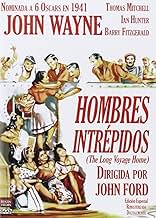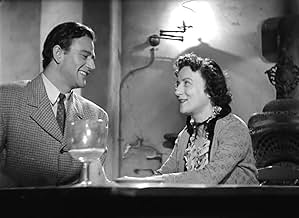IMDb RATING
6.9/10
5.2K
YOUR RATING
A merchant ship's crew tries to survive the loneliness of the sea and the coming of war.A merchant ship's crew tries to survive the loneliness of the sea and the coming of war.A merchant ship's crew tries to survive the loneliness of the sea and the coming of war.
- Nominated for 6 Oscars
- 3 wins & 7 nominations total
Wilfrid Lawson
- Captain
- (as Wilfred Lawson)
Joe Sawyer
- Davis
- (as Joseph Sawyer)
Constant Franke
- Norway
- (as Constant Frenke)
David Hillary Hughes
- Scotty
- (as David Hughes)
- Director
- Writers
- All cast & crew
- Production, box office & more at IMDbPro
Storyline
Did you know
- TriviaBarry Fitzgerald, who plays the character of Cocky, and Arthur Shields, who played Donkeyman, were brothers in real life. They also appeared together in director John Ford's The Quiet Man (1952).
- GoofsAt the beginning of the film, when Driscoll sneaks back to the ship, he jumps from a rowboat into the water and climbs up the anchor chain. The next time onscreen, he appears dry from head to toe.
- ConnectionsFeatured in Film Preview: Episode #1.2 (1966)
- SoundtracksBlow the Man Down
(uncredited)
Traditional
Played during the opening credits
Sung often by crewmen
Sung a cappella by J.M. Kerrigan
Variations played as part of the score
Featured review
Dark in tone, primarily enclosed on sound-stage, no major stars -- and Eugene O'Neill not an easy transfer from stage to screen -- this project does not have much working in its favour. But there's a great team at work here -- cameraman Gregg Toland, writer Dudley Nichols, director John Ford -- and an Irish-inflected ensemble, much like a troupe of players transported from Dublin's Abbey Theatre.
The Long Voyage Home compresses four short O'Neill plays into a single narrative, updated from World War I to the onset of World War II. The plays have been softened in language, and the overriding doom-and despair motif is lightened with bits of Irish-style shenanigans. Still, the considerable fidelity to O'Neill's text is one of the pleasures of viewing.
We are seldom outside the studio soundstage, but even with process shots and projections, the filmmakers still create the illusion of the open sea. The storm sequences have considerable impact, even for the contemporary viewer. Some sequences here are worthy of Ford's earlier spectacle The Hurricane, albeit on a smaller scale.
Toland's striking camerawork, with its deep focus and Expressionist lighting, gives the film a foreboding, unsettling quality, well suited to the precarious nature of the wartime voyage from the West Indies to England.
There's a likeable interplay among the actors. I get a bit tired of John Quelan with his whining falsetto brogue, and to an extent smart aleck Barry Fitzgerald with his supercilious chin. But I engage easily with Thomas Mitchell's bossy, streetwise good nature, and especially Ward Bond, who, contrary to his usual gruff, rough-edged manner, gets some soulful moments as the unlucky sailor named Yank.
Youthful John Wayne is surprisingly right as the Swedish sailor on his long voyage home, perhaps the pivotal member of this crew, attached to one another for better or for worse. He and dockside bar-maid Mildred Natwick share a few poignant moments in the last part of the film.
From a modern perspective, some sentiments and attitudes are incorrectly expressed, but in the period, Long Voyage Home admirably gives O'Neill a measure of 'realism' and respect from Hollywood. It is the only O'Neill film to be nominated for a Best Picture Oscar (and 5 other awards).
The Long Voyage Home compresses four short O'Neill plays into a single narrative, updated from World War I to the onset of World War II. The plays have been softened in language, and the overriding doom-and despair motif is lightened with bits of Irish-style shenanigans. Still, the considerable fidelity to O'Neill's text is one of the pleasures of viewing.
We are seldom outside the studio soundstage, but even with process shots and projections, the filmmakers still create the illusion of the open sea. The storm sequences have considerable impact, even for the contemporary viewer. Some sequences here are worthy of Ford's earlier spectacle The Hurricane, albeit on a smaller scale.
Toland's striking camerawork, with its deep focus and Expressionist lighting, gives the film a foreboding, unsettling quality, well suited to the precarious nature of the wartime voyage from the West Indies to England.
There's a likeable interplay among the actors. I get a bit tired of John Quelan with his whining falsetto brogue, and to an extent smart aleck Barry Fitzgerald with his supercilious chin. But I engage easily with Thomas Mitchell's bossy, streetwise good nature, and especially Ward Bond, who, contrary to his usual gruff, rough-edged manner, gets some soulful moments as the unlucky sailor named Yank.
Youthful John Wayne is surprisingly right as the Swedish sailor on his long voyage home, perhaps the pivotal member of this crew, attached to one another for better or for worse. He and dockside bar-maid Mildred Natwick share a few poignant moments in the last part of the film.
From a modern perspective, some sentiments and attitudes are incorrectly expressed, but in the period, Long Voyage Home admirably gives O'Neill a measure of 'realism' and respect from Hollywood. It is the only O'Neill film to be nominated for a Best Picture Oscar (and 5 other awards).
- How long is The Long Voyage Home?Powered by Alexa
Details
- Release date
- Country of origin
- Languages
- Also known as
- Eugene O'Neill's The Long Voyage Home
- Filming locations
- Los Angeles Harbor, Wilmington, Los Angeles, California, USA(scenes on S.S. Munami)
- Production companies
- See more company credits at IMDbPro
Box office
- Budget
- $682,495 (estimated)
- Runtime1 hour 45 minutes
- Color
- Aspect ratio
- 1.37 : 1
Contribute to this page
Suggest an edit or add missing content




































